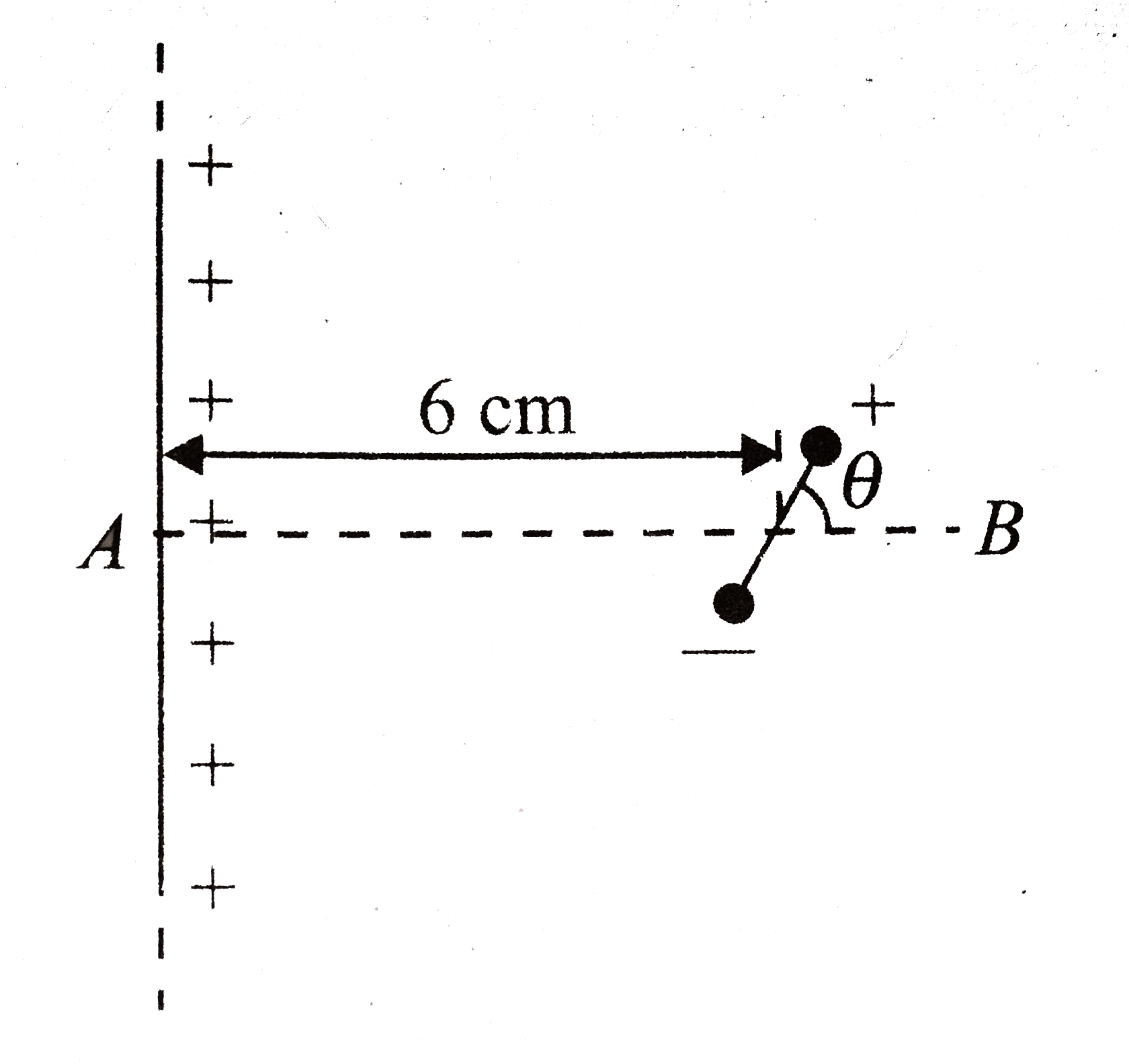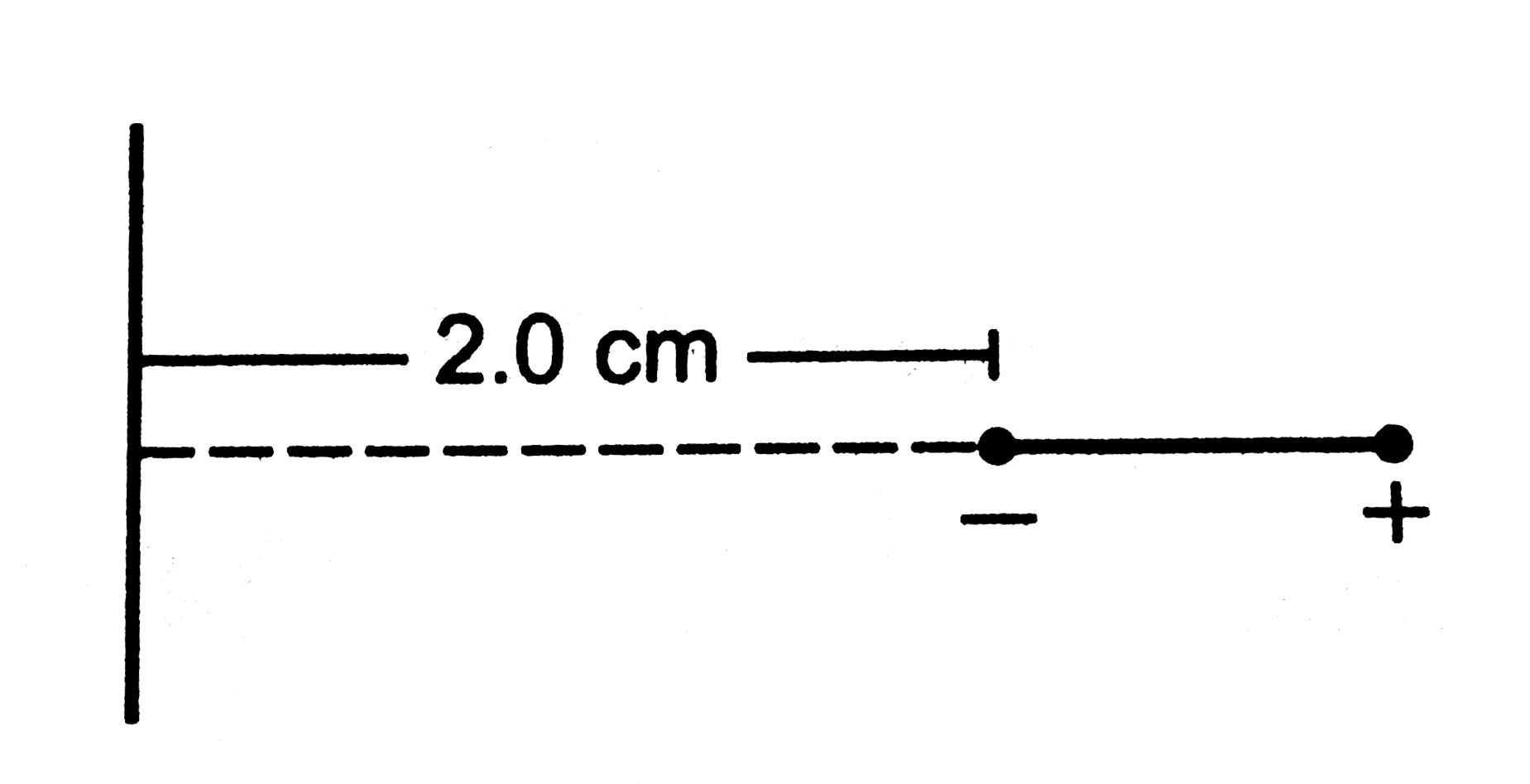A proton is released from rest, 10 cm from a charged sheet carrying charged density of −2.21×10−9C/m2. It will strike the sheet after the time (approximately)
4μs
2μs
2sqertμs
4√2μs
The correct Answer is:A
To solve the problem of a proton being released from rest and moving towards a charged sheet, we will follow these steps:
1. Identify Given Values:
- Charge density of the sheet, σ=−2.21×10−9C/m2
- Distance from the sheet, s=10cm=0.1m
- Charge of the proton, Q=1.6×10−19C
- Mass of the proton, m=1.67×10−27kg
2. Calculate the Electric Field (E) due to the Charged Sheet:
The electric field due to an infinite sheet with surface charge density σ is given by:
E=σ2ϵ0
where ϵ0=8.85×10−12C2/N m2.
Since the charge density is negative, the electric field will point towards the sheet.
3. Substitute the Values to Find E:
E=−2.21×10−92×8.85×10−12=−2.21×10−91.77×10−11≈−124.7N/C
4. Calculate the Force (F) on the Proton:
The force acting on the proton can be calculated using:
F=Q⋅E
Substituting the values:
F=(1.6×10−19)⋅(−124.7)≈−1.995×10−17N
5. Calculate the Acceleration (a) of the Proton:
Using Newton's second law, F=ma:
a=Fm=−1.995×10−171.67×10−27≈−1.194×1010m/s2
6. Use the Second Equation of Motion to Find Time (t):
Since the proton is released from rest, we can use the equation:
s=ut+12at2
Here, u=0, so:
s=12at2⟹t2=2sa
Substituting the values:
t2=2⋅0.11.194×1010≈1.674×10−11⟹t≈√1.674×10−11≈4.1×10−6s
7. Final Result:
The time taken for the proton to strike the sheet is approximately:
t≈4.1μs
- Charge density of the sheet, σ=−2.21×10−9C/m2
- Distance from the sheet, s=10cm=0.1m
- Charge of the proton, Q=1.6×10−19C
- Mass of the proton, m=1.67×10−27kg
The electric field due to an infinite sheet with surface charge density σ is given by:
E=σ2ϵ0
where ϵ0=8.85×10−12C2/N m2.
E=−2.21×10−92×8.85×10−12=−2.21×10−91.77×10−11≈−124.7N/C
The force acting on the proton can be calculated using:
F=Q⋅E
Substituting the values:
F=(1.6×10−19)⋅(−124.7)≈−1.995×10−17N
Using Newton's second law, F=ma:
a=Fm=−1.995×10−171.67×10−27≈−1.194×1010m/s2
Since the proton is released from rest, we can use the equation:
s=ut+12at2
Here, u=0, so:
s=12at2⟹t2=2sa
Substituting the values:
t2=2⋅0.11.194×1010≈1.674×10−11⟹t≈√1.674×10−11≈4.1×10−6s
The time taken for the proton to strike the sheet is approximately:
t≈4.1μs
Topper's Solved these Questions
- BOOK - DC PANDEY ENGLISHCHAPTER - ELECTROSTATICSEXERCISE - Level 1 Subjective15videos
ELECTROSTATICS
- BOOK - DC PANDEY ENGLISHCHAPTER - ELECTROSTATICSEXERCISE - SUBJECTIVE_TYPE6videos
ELECTROSTATICS
- BOOK - DC PANDEY ENGLISHCHAPTER - ELECTROSTATICSEXERCISE - Level 1 Assertion And Reason19videos
ELECTROSTATICS
- BOOK - DC PANDEY ENGLISHCHAPTER - ELECTROSTATIC POTENTIAL AND CAPACITORSEXERCISE - (C) Chapter exercises50videos
ELECTROSTATIC POTENTIAL AND CAPACITORS
- BOOK - DC PANDEY ENGLISHCHAPTER - GRAVITATIONEXERCISE - All Questions135videos
GRAVITATION
Similar Questions
An electric dipole consists of charges ±2.0×10−8 C separated by distance of ±2.0×10−3m. It is placed at a distance of 6 cm from a line charge of linear charge density 4.0×10−4Cm−1 as shown in figure such that the dipole makes an angle of θ=60∘ with line AB. Find the force acting on the dipole.
 View Solution
View SolutionA proton is fixed at origin. Another proton is released from rest, from a point at a distance r from origin. Taking charge of portion as e and mass as m, find the speed of the proton (i) at a distance 2r from origin (ii) at large distance from origin.
View SolutionTwo protons are a distance of 1×10−10cm from each other. The force acting on them are
View SolutionAn infinite thin plane sheet of charge density 7.08×10−11(C/m2) is held in air. Find the electric field at a point very close to the sheet.
View SolutionA flat square sheet of charge (side 50 cm) carries a uniform surface charge density. An electrons0.5 cm form a point near the center of the sheet experiences a force of 1.8×10−12N directed away from the sheet. Determine the total charge on the sheet.
View SolutionAn electric dipole consists of charges ±2.0×108C separated by a distance of 2.0×10−3 m. It is placed near a long ilne charge of linear charge density 4.0×10−4Cm−1 as shown in figure (30-W4), Such thet the negative charge is at a distance of 2.0 cm from the line charge. Find the force acting on the dipole.
 View Solution
View SolutionAn electric dipole consists of charges ±2.0×10−8C separated by a distance of 2.0×10−3 m. It is placed near a long line charge of linear charge density 4.0×10−4Cm−1 as shown in figure (30-W4), Such that the negative charge is at a distance of 2.0 cm from the line charge. Find the force acting on the dipole.
 View Solution
View SolutionSurface charge density of a sphere of a radius 10 cm is 8.85×10−8c/m2. Potential at the centre of the sphere is
View SolutionAn infinite nonconducting sheet of charge has a surface charge density of 107C/m2. The separation between two equipotential surfaces near the whose potential differ by 5V is
View SolutionAn infinite sheet of charge has a surfaces charge density of 10−7Cm2. The separation between two equipotential surfce whose potentials differ by 5V is
View Solution

